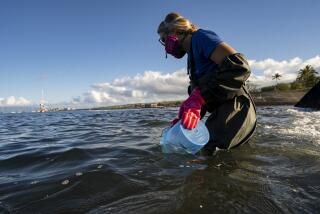The ‘Crocodile Saver’
THREE MONTHS ago, I stepped on a sea urchin in Hawaii, and my foot still hurts some. That’s hardly comparable to the sadly ironic death of “Crocodile Hunter” Steve Irwin, killed by the barb of a stingray, one of the ocean’s more benign creatures, while snorkeling on the Great Barrier Reef. Still, it reflects a truth about our ocean planet: that almost every creature of the sea has some kind of built-in mechanism or tool with which to defend itself, be it camouflage, shell, spine, tooth, stinger, venom or toxin.
Stingrays have accounted for only 17 deaths in the last decade, fewer even than sharks, which cause an average of eight human deaths worldwide every year. (We kill 100 million of these slow-growing predators a year, according to a U.N. report.) Irwin, whose “crikey” adrenalin-fueled joy at encountering and wrestling with various wild animals will be missed by millions of TV viewers, was taking a break from his latest documentary series, “The Ocean’s Deadliest,” when he died.
The show was to include encounters with various species of sharks, saltwater crocodiles and venomous sea snakes. Although these animals fall into the category of “charismatic megafauna” (animals we find either very cuddly or very scary), they don’t come close to reflecting the ocean’s true human-killers: the water itself, bacteria, jellyfish and algae.
The oceans are a rougher and more difficult wilderness for humans to function in than any encountered by terrestrial or space explorers. The sea pummels us with an unbreathable and corrosive liquid medium; altered visual and acoustic characteristics; changing temperatures, depth and pressures; upwellings; tides; currents; sudden storms and giant waves. Drowning, not animals, accounts for the vast majority of ocean-related deaths, including about 200,000 in the giant Asian tsunami of December 2004 and many of the 1,800 people who died as a result of Hurricane Katrina.
Warming oceans linked to climate change, and the runoff pollution from urban and agricultural activities, are increasing the number of red tides and other harmful algae blooms worldwide by feeding them the nutrients they need to grow. These in turn kill large numbers of marine mammals and fish and, occasionally, people, either through direct contact or indirectly through paralytic shellfish poisoning and other forms of contamination of the marine food web. The number of oceanic dead zones linked to algae blooms has more than doubled since the 1970s, to 146.
In Australia, box jellyfish are among the deadliest forms of ocean life, with one species, Chironex flecken, considered the world’s most venomous marine creature. Found in the northern tropics, they float close to shore in the warmer months. Swimmers encountering the near-transparent jellies’ long tentacles will experience excruciating pain at best.
Global warming and the loss of predators to fishing nets are leading to a bloom of jellyfish all over the world. Although education and rapid anti-venom treatment keep Australia’s death toll down to one or two a year, in the Philippines, jellies may account for 20 to 40 deaths a year. Other stinging critters include Portuguese man-of-wars (actually a colony of animals that looks like a jellyfish but technically isn’t), which sting half a million Americans each year; stonefish; lionfish (which have recently been introduced into U.S. waters from their native South Pacific, most likely through people dumping their aquariums); fire coral; anemones, and sea snakes, which tend to be far more venomous than their land-based cousins.
Once, while scuba diving in Australia, I stopped watching a lionfish to follow a beautifully colored 7-foot sea snake until it slid off into the depths. “And what were you going to do if you caught up with it?” my girlfriend inquired when we were back on the boat.
It’s hard to deny the atavistic pleasure of getting close to (or watching someone else get close to) big things that can kill you with teeth, claws or venom, which was Steve Irwin’s specialty. It’s also a pleasure that millions could indulge in guilt-free with Irwin because he often included a conservation message in his shows, mentioning that we should protect and conserve the king cobra, Komodo dragon or whatever other deadly critter he was handling. The crocodiles he “hunted” he later released after relocating them away from human settlements.
As truly wild habitat for terrestrial creatures has disappeared, Irwin, an iconic Australian, increasingly turned to the sea around him. He was working on “The Ocean’s Deadliest” project with Philippe Cousteau, the grandson of famed ocean explorer and conservationist Jacques Cousteau. It’s not hard to imagine that, like the elder Cousteau, Irwin’s joyful and hugely popular exploits might have, over time and as he aged, become a more explicit forum in which he’d challenge us to protect, restore and value the wild side of our blue marble planet. Without him, we’ll have to do it on our own.
More to Read
Start your day right
Sign up for Essential California for news, features and recommendations from the L.A. Times and beyond in your inbox six days a week.
You may occasionally receive promotional content from the Los Angeles Times.






